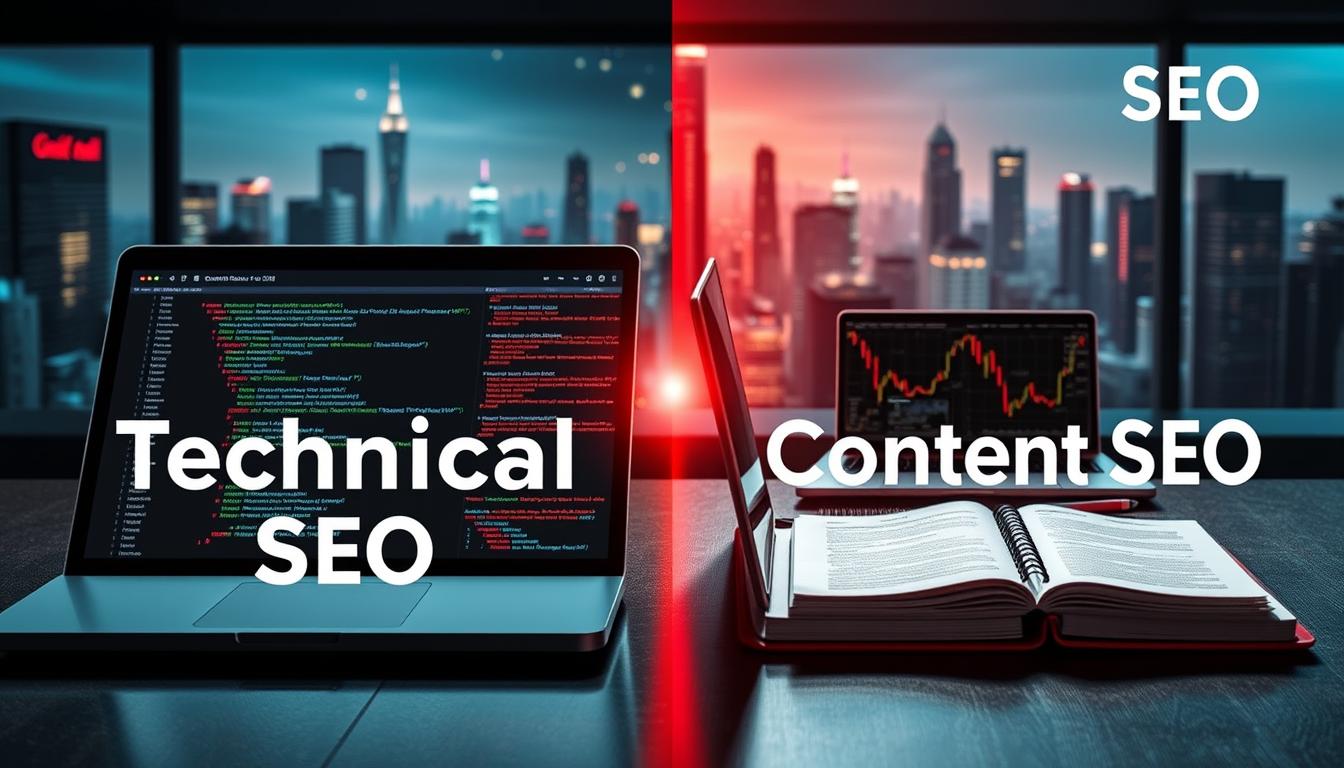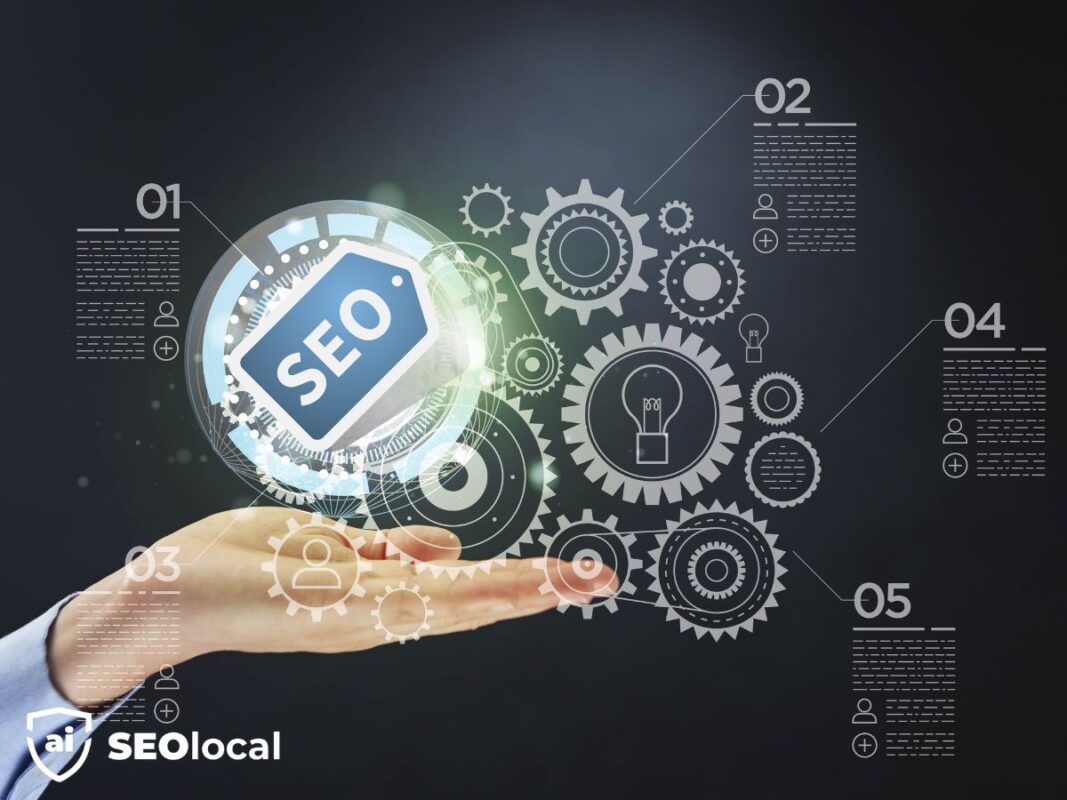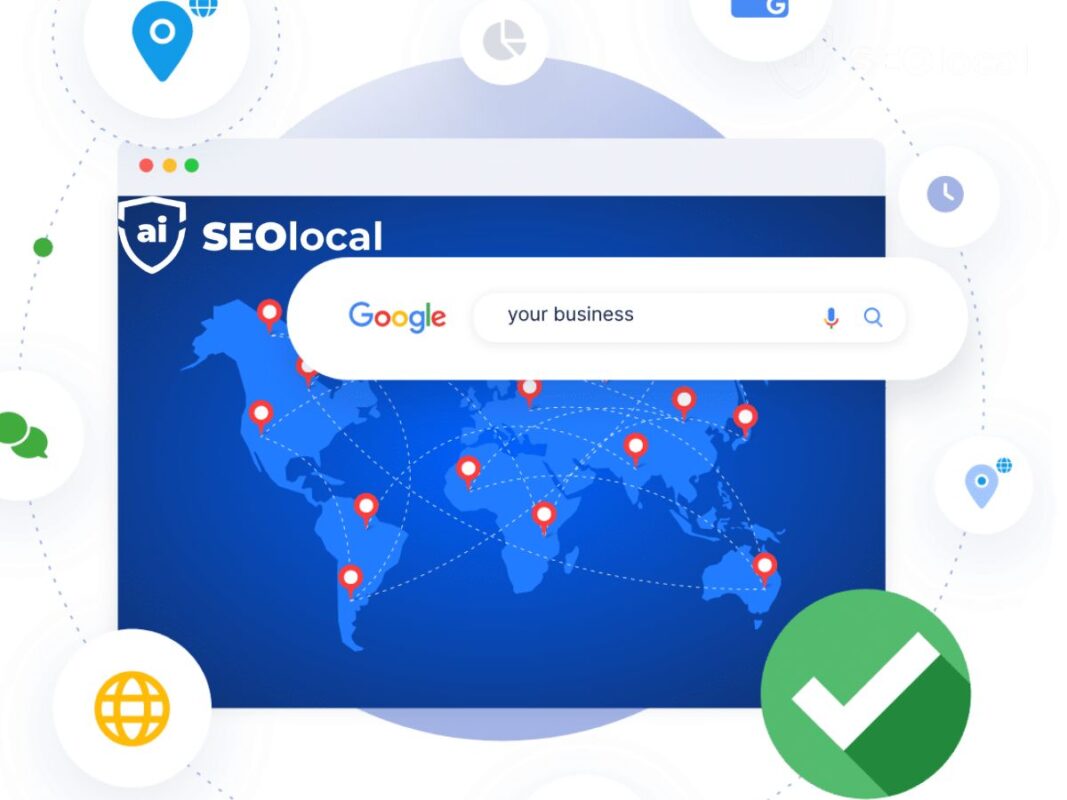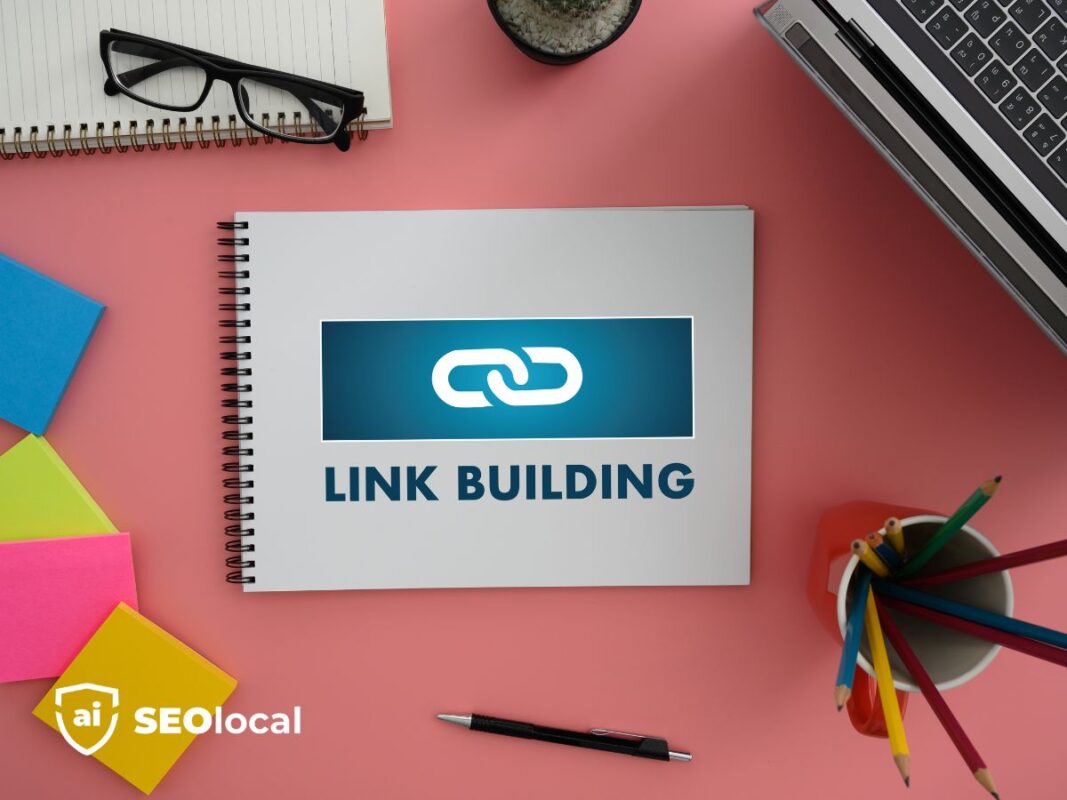- Advanced Local SEO Strategies
- Fundamentals of Local SEO
- Google Business Profile (GBP) Optimization
- Local Keywords and Content Strategy
- Local Link Building
- Local Paid Advertising
- Local Search Ranking Factors
- Local SEO Best Practices
- Local SEO Tools and Analytics
- Local Social Media Marketing
- Online Reviews and Reputation Management
- Technical SEO for Local Businesses
The Difference Between Technical SEO and Content SEO

Most online content disappears into obscurity because creators focus on just one side of search engine optimization. While many obsess over keywords or backlinks, they often miss the critical balance between infrastructure and messaging that search engines demand.
Search engine optimization operates like a digital handshake. Your website’s technical setup tells algorithms “I’m accessible,” while quality content shouts “I’m relevant!” Together, they determine whether your pages climb rankings or stay buried.
Imagine building a library with broken shelves (technical flaws) filled with blank books (poor content). Neither scenario helps visitors find value. This guide breaks down how both elements work in tandem, helping you avoid common pitfalls that keep 9 out of 10 websites invisible.
Key Takeaways
- Technical SEO ensures search engines can access and understand your site’s structure
- Content SEO focuses on creating valuable material that answers user queries
- Both strategies require equal attention for sustainable organic growth
- Search algorithms penalize sites that excel in one area but neglect the other
- Proper implementation boosts visibility across all stages of the search journey
- Balancing these approaches prevents wasted resources on partial optimizations
Understanding the Foundations of SEO
Mastering SEO fundamentals unlocks sustainable growth without relying on paid ads. Unlike temporary marketing tactics, search engine optimization builds lasting visibility by aligning your digital presence with user needs and algorithmic priorities.
How Organic Visibility Works
Search engines act as matchmakers between questions and answers. When someone types a query, algorithms scan millions of pages to find the best solutions. Your content earns traffic by satisfying both user intent and technical requirements.
Google handles 85% of global searches, using 200+ ranking factors to evaluate websites. These include page speed, mobile compatibility, and content depth. Optimizing for these elements helps your site appear when users seek your expertise.
Why Search Algorithms Matter
Modern search engines analyze context rather than just keywords. They assess content quality, user engagement metrics, and website authority. Understanding these criteria helps create pages that algorithms prioritize.
Businesses using SEO effectively gain consistent traffic without per-click costs. This approach works for local shops and global brands alike. Strategic optimization makes your digital assets discoverable to precisely targeted audiences.
Defining Technical SEO
Behind every high-ranking website lies a hidden framework that search engines rely on. Technical SEO shapes this digital backbone, ensuring your pages communicate effectively with algorithms. It transforms raw content into machine-readable signals while optimizing performance for human visitors.
Core Technical Elements and Best Practices
Your website’s architecture acts like a blueprint for search engines. Clean HTML tags guide bots through headers and meta descriptions. Schema markup adds context, helping algorithms categorize product details or event dates accurately.

Image optimization reduces load times without sacrificing quality. Compressed files and descriptive alt text improve accessibility while boosting page speed. Mobile responsiveness ensures seamless browsing across devices – a critical factor since Google prioritizes mobile-first indexing.
Improving Crawlability and Site Structure
Logical hierarchies make navigation intuitive for users and bots. Internal linking connects related content, spreading authority throughout your site. XML sitemaps act as roadmaps, while robots.txt files prevent wasted crawl budgets on duplicate pages.
Flat site structures keep important pages within three clicks of the homepage. Proper use of canonical tags avoids content duplication issues. These adjustments help search engines index your content faster, making new pages visible in results sooner.

Defining Content SEO
Content SEO bridges the gap between algorithms and human needs. This strategy transforms raw information into search-friendly material that answers real questions while meeting technical requirements. Unlike generic writing, it requires balancing user value with structured optimization.
Crafting Valuable Content for Your Audience
Start by mapping your readers’ journey. Identify their pain points through forums, reviews, and social media discussions. Create guides that solve specific problems rather than generic overviews.
Structure content using clear headers and subheaders. Break complex ideas into digestible sections with bullet points or numbered lists. Use real-world examples to demonstrate concepts, keeping paragraphs under four lines for easy scanning.
Effective Keyword Research and On-Page Optimization
Keyword tools reveal what phrases your audience actually uses. Target long-tail phrases like “best running shoes for flat feet” instead of broad terms. These specific queries attract qualified visitors more likely to convert.
| Component | Purpose | Example |
|---|---|---|
| Header Tags | Organize content hierarchy | H2: Marathon Training Tips |
| Meta Descriptions | Improve click-through rates | “Discover 5 proven recovery techniques for runners” |
| Internal Links | Boost page authority | Link “hydration strategies” to related guide |
Optimize existing content by updating statistics and adding multimedia. Fresh information signals relevance to search engines. Track time-on-page metrics to identify which topics resonate most with readers.
What is the difference between technical SEO and content SEO?
Effective SEO requires two pillars working in harmony: one builds the road, the other drives the traffic. Technical SEO forms your website’s infrastructure, while content SEO delivers the messages travelers seek. Both elements must align to guide visitors from discovery to engagement.
Technical SEO focuses on backend mechanics that help search engines navigate your site. Key elements include mobile responsiveness, page loading speed, and proper URL structuring. These factors determine whether algorithms can access and interpret your pages efficiently.
Content SEO revolves around creating material that answers user questions and solves problems. It involves strategic keyword placement, topic depth, and clear information architecture. This approach ensures visitors find value once they arrive at your site.
| Focus Area | Technical SEO | Content SEO |
|---|---|---|
| Primary Goal | Machine accessibility | Human relevance |
| Key Elements | Site speed, XML sitemaps, crawl optimization | Keyword research, content quality, meta descriptions |
| User Impact | Faster navigation | Longer engagement |
Neglecting either component creates imbalance. Slow-loading pages frustrate users despite great content. Well-structured sites without valuable information leave visitors unsatisfied. Regular audits help maintain synergy between these critical functions.
Prioritize technical fixes first to ensure search engines can find your content. Then refine messaging to match what your audience actively seeks. This dual approach creates lasting visibility in competitive search landscapes.
Integrating Technical SEO and Content SEO
Building a successful online presence resembles constructing a digital storefront. Your technical setup acts as the foundation and plumbing, while content serves as the merchandise and signage. Without both elements working together, potential customers walk past empty shelves or struggle to find what they need.
Creating a Balanced SEO Strategy
Start by aligning your technical infrastructure with content goals. Fix crawl errors before launching new articles. Optimize existing pages for mobile users while updating their information. This dual approach ensures search engines can access your material and visitors find it valuable.
| Focus Area | Technical Actions | Content Actions |
|---|---|---|
| Site Performance | Compress images, enable caching | Add relevant visuals to support text |
| User Engagement | Improve mobile responsiveness | Create scannable headers and bullet points |
| Keyword Targeting | Optimize URL structures | Implement natural keyword placement |
Monitoring Performance and Making Adjustments
Use tools like Google Search Console to track crawl stats alongside content metrics. Compare page speed improvements with bounce rate changes. If technical upgrades don’t boost engagement, revisit your content’s relevance to user intent.
Prioritize fixes that impact both areas simultaneously. Accelerating load times improves user experience while meeting technical requirements. Updating old content with fresh data satisfies readers and signals freshness to algorithms.
Comparative Analysis of SEO Strategies
Effective digital visibility requires mastering both infrastructure and messaging. Technical SEO and content SEO serve different purposes but share the same end goal: improving search rankings while enhancing user experiences.
Strengths and Limitations of Each Approach
Technical SEO excels at foundational improvements. It boosts site speed by compressing files and optimizes website structure for better crawlability. These aspects help pages load faster and appear higher in search results.
However, technical SEO alone can’t engage visitors. It focuses on backend aspects like mobile optimization but doesn’t address whether content answers user questions. This gap highlights the need for complementary content strategies.
| Aspect | Technical SEO | Content SEO |
|---|---|---|
| Primary Strength | Improves site accessibility | Answers specific user queries |
| Key Limitation | Doesn’t create engagement | Requires technical support |
| Impact on Rankings | Enables crawling/indexing | Signals topical authority |
Identifying Areas of Overlap and Synergy
Page speed optimization demonstrates how these strategies intersect. Faster loading times (technical) keep users engaged with content longer (content). Mobile-friendly designs ensure articles display properly across devices.
Internal linking shows another synergy. Well-structured navigation (technical) helps distribute authority to key pages (content). Both approaches ultimately aim to satisfy search algorithms while meeting human needs.
Prioritize technical fixes first to ensure your content reaches audiences. Then refine messaging to maintain engagement. This balanced implementation prevents wasted efforts and maximizes search visibility.
Impact on User Experience and Search Engine Rankings
Your website’s performance hinges on two critical factors that shape visitor interactions and search visibility. Technical optimizations ensure smooth browsing, while quality material keeps audiences engaged. Together, these elements influence how algorithms perceive and prioritize your pages.
Improving Page Speed and Navigation
Faster load times directly boost user satisfaction. Compressed images and clean code reduce waiting periods, decreasing bounce rates by up to 38%. Intuitive menus help visitors find information quickly, signaling to search engines that your site delivers value efficiently.
Enhancing Content Engagement and Dwell Time
Relevant articles and guides encourage longer browsing sessions. Clear headers and actionable tips increase average page views by 25%. Search algorithms interpret extended dwell times as quality signals, often rewarding these pages with higher rankings.
Balancing technical precision with audience-focused content creates a virtuous cycle. Smooth navigation retains users, while valuable material converts casual visitors into loyal readers. This dual optimization approach maximizes both search visibility and real-world results.
FAQ
How do technical SEO and content SEO influence search engine rankings differently?
Technical SEO focuses on backend elements like site speed, crawlability, and mobile-friendliness to help engines index pages efficiently. Content SEO prioritizes keyword research, meta descriptions, and high-quality articles to align with user intent and boost relevance in results.
Which elements of a website require technical optimization for better performance?
Critical technical aspects include improving page load times, fixing broken links, optimizing image alt text, and ensuring proper URL structure. These adjustments enhance crawlability, reduce bounce rates, and support higher rankings on platforms like Google.
Why is keyword research vital for content marketing success?
Identifying terms your audience searches for ensures content addresses their needs. Tools like Google Keyword Planner or SEMrush reveal gaps in your strategy, letting you craft articles, blogs, or product pages that drive organic traffic and improve visibility.
How does user experience connect to both SEO strategies?
Fast-loading pages (technical) and engaging headlines (content) keep visitors on-site longer. Search engines reward lower bounce rates and higher dwell time with improved rankings, making UX a shared priority for both approaches.
Can neglecting meta descriptions harm your search engine performance?
Yes. Poorly written meta tags reduce click-through rates, signaling low relevance to algorithms. Optimizing them with target keywords and clear value propositions strengthens content SEO while supporting technical efforts to boost SERP visibility.
What role do internal links play in balancing SEO strategies?
Internal linking improves navigation (technical) and distributes authority to priority pages (content). For example, linking blog posts to service pages guides users and helps engines understand site structure, creating synergy between both tactics.






